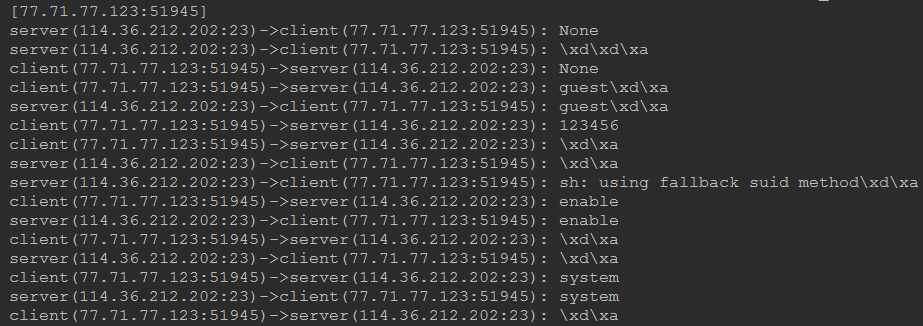python3+pyshark读取wireshark数据包并追踪telnet数据流
一、程序说明
本程序有两个要点,第一个要点是读取wireshark数据包(当然也可以从网卡直接捕获改个函数就行),这个使用pyshark实现。pyshark是tshark的一个python封装,至于tshark可以认为是命令行版的wireshark,随wireshark一起安装。
第二个要点是追踪流,追踪流在wireshark中是“tcp.stream eq 70”之类的形式,但是70这类值暂是不知道具体怎么计算出来的,但从网上资料看,是依据[IP address A, TCP port A, IP address B, TCP port B]四元组计算出来的,只要这四个值一样那么计算出来的tcp.stream也就一样,就认为是同一个流。那么,反过来也就是说“tcp.stream eq 70”这种形式,其实等价于"ip.addr == ip_a and tcp.port == port_a and ip.addr == ip_b and tcp.port == port_b"的形式,我们这里就是用这种形式来追踪telnet流。
至于为什么一再强调是追踪telnet流而不是追踪流,是因为感觉各应用层协议没有统一获取应用层协议内容的方法,比如这里通过tmp_packet[highest_layer_name].get_field('data')形式读取telnet数据的,但http则得用tmp_packet['http'].file_data读取,ftp等其他协议又要通过其他不同属性来获取。
另外还要说明的一点是,数据包的每次过滤主要是借助写display_filter重新读取数据包文件,而不是将所有数据包读入后自己写代码进行过滤(就实际来看这种方法比借助写display_filter重新读取数据包文件要复杂且运行速度要慢)或者写display_filter进行二次过滤(tshark本身就不支持二次过滤,就观察来看wireshark自己也没有二次过滤这种东西在执行过滤器表达式时都是重新读取数据包文件)
运行效果如下:

二、程序源代码
import pyshark
class wireshark_analysis_script():
# 此函数的作用是封装一下pyshark.FileCapture
def read_packets_from_file(self,packets_file_path,tshark_path,display_filter):
packets_file_obj = pyshark.FileCapture(input_file=packets_file_path,tshark_path=tshark_path,display_filter=display_filter)
return packets_file_obj
# 此函数的作用是从传送过来的所有数据包中,抽取并返回{ip_server,ip_client,port_server,port_client}四元组
def get_target_client_ip_port(self,packets_file_obj):
for tmp_packet in packets_file_obj:
ip_server = tmp_packet.ip.src
port_server = tmp_packet.tcp.srcport
ip_client = tmp_packet.ip.dst
port_client = tmp_packet.tcp.dstport
yield {"ip_server":ip_server,"port_server":port_server,"ip_client":ip_client, "port_client":port_client}
# 此函数的作用是读取传过来的所有数据包应用层的数据,并打印
def follow_tcp_stream(self,packets_file_obj,ip,port):
for tmp_packet in packets_file_obj:
highest_layer_name = tmp_packet.highest_layer
if ((tmp_packet.ip.dst == ip) and (tmp_packet.tcp.dstport == port)):
print("server(%s:%s)->client(%s:%s): %s" % (tmp_packet.ip.src, tmp_packet.tcp.srcport, tmp_packet.ip.dst, tmp_packet.tcp.dstport, tmp_packet[highest_layer_name].get_field('data')))
elif ((tmp_packet.ip.src == ip) and (tmp_packet.tcp.srcport == port)):
print("client(%s:%s)->server(%s:%s): %s" % (tmp_packet.ip.src, tmp_packet.tcp.srcport, tmp_packet.ip.dst, tmp_packet.tcp.dstport, tmp_packet[highest_layer_name].get_field('data')))
if __name__ == '__main__':
# 要读取的wireshark数据包的所在的路径
packets_file_path = 'F:\\PycharmProjects\\telnet\\pyshark_pack'
# tshark程序所在的路径,tshark随wireshark安装
tshark_path = 'D:\\tools\\Wireshark\\tshark.exe'
# 过滤器表达式,与在wireshark中使用时的写法完全相同
first_step_filter = 'telnet contains "HiLinux"'
# 用于存放要追踪流的ip和端口
target_client_ip_port = []
# 实例化类
wireshark_analysis_script_instance = wireshark_analysis_script()
# 使用first_step_filter过滤器表达式,过滤出要追踪流的数据包
first_step_obj = wireshark_analysis_script_instance.read_packets_from_file(packets_file_path, tshark_path, first_step_filter)
# 从要追踪流的数据包中抽取出ip和端口
target_client_ip_port = wireshark_analysis_script_instance.get_target_client_ip_port(first_step_obj)
first_step_obj.close()
# 遍历要追踪流的ip+端口组合
for target_client_ip_port_temp in target_client_ip_port:
ip_server = target_client_ip_port_temp['ip_server']
port_server = target_client_ip_port_temp['port_server']
ip_client = target_client_ip_port_temp['ip_client']
port_client = target_client_ip_port_temp['port_client']
# 这里是追踪流的关键,所有数据包中如果数据包中{ip_server,ip_client,port_server,port_client}四元组相同,那么就认为是同一个流
# 当然追踪流一般都是追踪应用层的数据流,所以加上应用层协议运行过滤去掉三次握手四次挥手等没有应用层数据的数据包;我这里要追踪telnet数据流,所以除四元组外还加了telnet做过滤
second_step_filter = 'telnet and ip.addr == %s and ip.addr == %s and tcp.port == %s and tcp.port == %s' % (ip_server,ip_client,port_server,port_client)
second_step_obj = wireshark_analysis_script_instance.read_packets_from_file(packets_file_path, tshark_path, second_step_filter)
print("[%s:%s]" % (ip_client, port_client))
# 调用follow_tcp_stream将认为是同一个流的所有数据包的应用层数据打印
wireshark_analysis_script_instance.follow_tcp_stream(second_step_obj, ip_client, port_client)
second_step_obj.close()
三、使用与wireshark一致的形式【20180929更新】
在前边的解决方案中,我们使用"ip.addr == ip_a and tcp.port == port_a and ip.addr == ip_b and tcp.port == port_b"等价代替wireshark中“tcp.stream eq 70”的形式来实现追踪流,当时的想法是不知道某个流的70这种值如何计算。
现在发现这种值pyshark在tcp.stream属性直接给出了,所以我们完全可以使用和wireshark的“tcp.stream eq 70”一致的形式来追踪流。第二大节程序可等介修改如下。
(当然因为是等价形式所以输出结果还是一样的,都是要重新解析数据包文件所以效率也就差不多,主要是为了说追流可以使用和wireshark一样的形式)
import pyshark
class wireshark_analysis_script():
# 此函数的作用是封装一下pyshark.FileCapture
def read_packets_from_file(self, packets_file_path, tshark_path, display_filter):
packets_file_obj = pyshark.FileCapture(input_file=packets_file_path, tshark_path=tshark_path, display_filter=display_filter)
return packets_file_obj
# 此函数的作用是从传送过来的所有数据包中,抽取并返回{ip_server,ip_client,port_server,port_client}四元组
def get_target_client_ip_port(self, packets_file_obj):
for tmp_packet in packets_file_obj:
ip_server = tmp_packet.ip.src
port_server = tmp_packet.tcp.srcport
ip_client = tmp_packet.ip.dst
port_client = tmp_packet.tcp.dstport
stream_value = tmp_packet.tcp.stream
yield {"ip_server": ip_server, "port_server": port_server, "ip_client": ip_client, "port_client": port_client,"stream_value":stream_value}
# 此函数的作用是读取传过来的所有数据包应用层的数据,并打印
def follow_tcp_stream(self, packets_file_obj, ip, port):
for tmp_packet in packets_file_obj:
highest_layer_name = tmp_packet.highest_layer
#追踪流时会有握手挥手tcp将其排除
if highest_layer_name != "TCP":
if ((tmp_packet.ip.dst == ip) and (tmp_packet.tcp.dstport == port)):
print("server(%s:%s)->client(%s:%s): %s" % (tmp_packet.ip.src, tmp_packet.tcp.srcport, tmp_packet.ip.dst, tmp_packet.tcp.dstport, tmp_packet[highest_layer_name].get_field('data')))
elif ((tmp_packet.ip.src == ip) and (tmp_packet.tcp.srcport == port)):
print("client(%s:%s)->server(%s:%s): %s" % (tmp_packet.ip.src, tmp_packet.tcp.srcport, tmp_packet.ip.dst, tmp_packet.tcp.dstport, tmp_packet[highest_layer_name].get_field('data')))
if __name__ == '__main__':
# 要读取的wireshark数据包的所在的路径
packets_file_path = 'F:\\PycharmProjects\\telnet\\pyshark_pack'
# tshark程序所在的路径,tshark随wireshark安装
tshark_path = 'D:\\tools\\Wireshark\\tshark.exe'
# 过滤器表达式,与在wireshark中使用时的写法完全相同
first_step_filter = 'telnet contains "HiLinux"'
# 用于存放要追踪流的ip和端口
target_client_ip_port = []
# 实例化类
wireshark_analysis_script_instance = wireshark_analysis_script()
# 使用first_step_filter过滤器表达式,过滤出要追踪流的数据包
first_step_obj = wireshark_analysis_script_instance.read_packets_from_file(packets_file_path, tshark_path, first_step_filter)
# 从要追踪流的数据包中抽取出ip和端口
target_client_ip_port = wireshark_analysis_script_instance.get_target_client_ip_port(first_step_obj)
first_step_obj.close()
# 遍历要追踪流的ip+端口组合
for target_client_ip_port_temp in target_client_ip_port:
# stream的值
stream_value = target_client_ip_port_temp['stream_value']
ip_client = target_client_ip_port_temp['ip_client']
port_client = target_client_ip_port_temp['port_client']
# tcp.stream eq 70形式。为了排除tcp其实可以再直接加上and telnet
second_step_filter = 'tcp.stream eq %s' % (stream_value)
second_step_obj = wireshark_analysis_script_instance.read_packets_from_file(packets_file_path, tshark_path, second_step_filter)
print("[%s:%s]" % (ip_client, port_client))
# 调用follow_tcp_stream将认为是同一个流的所有数据包的应用层数据打印
wireshark_analysis_script_instance.follow_tcp_stream(second_step_obj, ip_client, port_client)
second_step_obj.close()
参考:
http://kiminewt.github.io/pyshark/
https://www.wireshark.org/docs/wsug_html_chunked/
https://medium.com/@asfandyar.khalil/tcp-stream-in-pcap-file-using-python-6991a8e7b524
python3+pyshark读取wireshark数据包并追踪telnet数据流的更多相关文章
- 《Wireshark数据包分析实战》 - http背后,tcp/ip抓包分析
作为网络开发人员,使用fiddler无疑是最好的选择,方便易用功能强. 但是什么作为爱学习的同学,是不应该止步于http协议的,学习wireshark则可以满足这方面的需求.wireshark作为抓取 ...
- WireShark数据包分析数据封装
WireShark数据包分析数据封装 数据封装(Data Encapsulation)是指将协议数据单元(PDU)封装在一组协议头和尾中的过程.在OSI七层参考模型中,每层主要负责与其它机器上的对等层 ...
- Wireshark数据包分析入门
Wireshark数据包分析(一)——使用入门 Wireshark简介: Wireshark是一款最流行和强大的开源数据包抓包与分析工具,没有之一.在SecTools安全社区里颇受欢迎,曾一度超越 ...
- wireshark数据包分析
最近有不少同事开始学习Wireshark,他们遇到的第一个困难就是理解不了主界面上的提示信息,于是跑来问我.问的人多了,我也总结成一篇文章,希望对大家有所帮助.Wireshark的提示可是其最有价值之 ...
- Wireshark数据包分析(一)——使用入门
Wireshark简介: Wireshark是一款最流行和强大的开源数据包抓包与分析工具,没有之一.在SecTools安全社区里颇受欢迎,曾一度超越Metasploit.Nessus.Aircrack ...
- wireshark数据包分析实战 第三、四章
1,wireshark支持的协议上千种,开源的. 2,wireshark需要winpcap驱动支持.winpcap驱动的作用通过操作系统捕捉原始数据包.应用过滤器.将网卡切换为混杂模式. 3,捕获文件 ...
- wireshark数据包分析实战 第一章
1,数据包分析工具:tcpdump.wireshark.前者是命令行的,后者是图形界面的. 分析过程:收集数据.转换数据(二进制数据转换为可读形式).分析数据.tcpdump不提供分析数据,只将最原始 ...
- WireShark数据包分析一:认识WireShark
一.认识WireShark WireShark是一款抓包软件,官方网址:WireShark.org 官网如下图: 选择Download,在官网下载安装WireShark即可. WireShark可用来 ...
- wireshark数据包分析实战 第二章
1,监听网络线路:即嗅探器的位置确定. 2,混杂模式:将网卡设置成混杂模式,网卡可以接受经过网卡的所有数据报,包括目的地址不是本网卡的数据报.这些数据都会发送给cpu处理,这样,wireshark就能 ...
随机推荐
- toggle 1.9 以后就被删除了
toggle 1.9 以后就被删除了, 1.8.x 以前可用. $(function(){ $(".p_title").toggle( function(){ $(this).n ...
- 【Ruby】【改gem源镜像】【Win10 + Jruby-9.1.2.0 + Rails 5.1.3 + gem 2.6.4 】
参考地址:https://ruby-china.org/topics/33843 (1)> gem sources --add http://gems.ruby-china.org 遇到问题: ...
- 【一】jquery之subline编辑器插件安装
1.地址下载:https://pan.baidu.com/share/link?shareid=552312&uk=151954025 2.打开Sublime, 选择 Prefreences ...
- centos nginx 中安装ssl证书 以及在项目中的使用
今天阿里云的证书到期了,重新申请了一个,下面是从申请到安装以及结合项目使用的过程: 1.登录阿里云 2.在左侧找到SSL证书 3.申请免费的证书 4.下载证书 5.根据说明配置nginx 6.在项 ...
- Spring boot @Scheduled(cron = "* * * * * *") cron表达式详解
//@Scheduled(cron = "0 0/15 * * * ?") //每15分钟触发一次 //@Scheduled(cron = "5/10 * * * * ? ...
- vuex中的辅助函数 mapState,mapGetters, mapActions, mapMutations
1.导入辅助函数 导入mapState可以调用vuex中state的数据 导入mapMutations可以调用vuex中mutations的方法 四个辅助函数 各自对应自己在vuex上的自己 2.ma ...
- 《剑指offer》第四十三题(从1到n整数中1出现的次数)
// 面试题43:从1到n整数中1出现的次数 // 题目:输入一个整数n,求从1到n这n个整数的十进制表示中1出现的次数.例如 // 输入12,从1到12这些整数中包含1 的数字有1,10,11和12 ...
- vscode 常用扩展推荐
1.扩展推荐 Beautify Beautify code in place for VS Code CSS Formatter Formatter for CSS ESLint ...
- vue-cli3快速创建项目
文档:https://cli.vuejs.org/zh/guide/ 条件: npm 更至最新 node >=8.9 1.全局安装 npm install -g @vue/cli 或 yarn ...
- vuex 源码:深入 vuex 之辅助函数 mapState
前言 当一个组件要获取多个 state 的时候,声明计算属性就会变得重复和冗余了.我们可以使用到辅助函数 mapState 来更快更简洁地生成计算属性. 所以我们得清楚,mapState 的作用就是帮 ...
